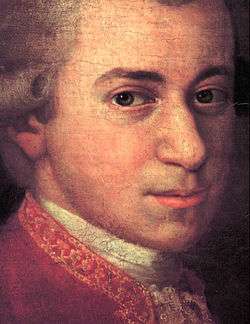Sonata for Two Pianos in D major (Mozart)

The Sonata for Two Pianos in D major, K. 448 is a work composed by Wolfgang Amadeus Mozart in 1781, when he was 25. It is written in strict sonata-allegro form, with three movements. The sonata was composed for a performance he would give with fellow pianist Josephine von Aurnhammer.[1] Mozart composed this in the galant style, with interlocking melodies and simultaneous cadences. This is one of his few compositions written for two pianos. This sonata was also used in the scientific study that tested the theory of the Mozart effect, suggesting that classical music increases brain activity more positively than other kinds of music.[2][3]
Description
 |
Sonata for Two Pianos in D major (5:54)
Recorded in November 2005 |
| Problems playing this file? See media help. | |
The sonata is written in three movements,
- Allegro con spirito
- Andante in G major
- Molto Allegro.
Allegro con spirito
The first movement begins in D major, and sets the tonal center with a strong introduction. The two pianos divide the main melody for the exposition, and when the theme is presented both play it simultaneously. Mozart spends little time in the development introducing a new theme unlike most sonata forms, and begins the recapitulation, repeating the first theme.
Andante
The second movement is written in a strict ABA form.
Molto Allegro
Molto Allegro begins with a galloping theme. The cadences used in this movement are similar to those in Mozart's Rondo alla Turca.
Mozart effect
 |
Acroyali/Standing in Motion (30-second sample)
This composition by Yanni has been deemed similar to Mozart's K 448 in character and effect, by the Journal of the Royal Society of Medicine[2][3] |
| Problems playing this file? See media help. | |
According to the British Epilepsy Organization, research has suggested that Mozart's K 448 can have the "Mozart effect", in that listening to the piano sonata improved spatial reasoning skills and reduced the number of seizures in people with epilepsy. Apart from another Mozart Concerto, K 488, only one other piece of music has been found to have a similar effect, a song by the Greek composer Yanni, entitled "Acroyali/Standing In Motion", which is featured on his album Yanni Live at the Acropolis.[3] It was determined to have the "Mozart effect", by the Journal of the Royal Society of Medicine because it was similar to Mozart's K 448 in tempo, structure, melodic and harmonic consonance and predictability.[2][3]
Notes
External links
- Sonate in D für Zwei Klaviere KV 448: Score and critical report (German) in the Neue Mozart-Ausgabe
- Recording of Sonata for Two Pianos in D major by Sivan Silver and Gil Garburg (archived on the Wayback Machine)
- Sonata for Two Pianos: Scores at the International Music Score Library Project
